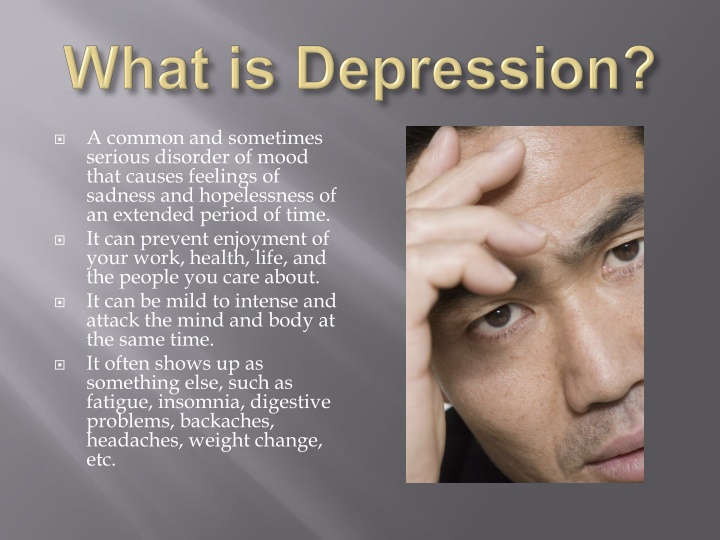
Depression: Types, Symptoms, and Treatment Options
Depression is a common mood disorder that can profoundly impact one's life. Learn about different types of depression, symptoms to watch for, and effective treatment strategies that include psychotherapy, medications, and lifestyle changes. Evaluate the risk factors and statistics associated with depression to better understand its prevalence and potential impact on health.
Download Presentation

Please find below an Image/Link to download the presentation.
The content on the website is provided AS IS for your information and personal use only. It may not be sold, licensed, or shared on other websites without obtaining consent from the author. If you encounter any issues during the download, it is possible that the publisher has removed the file from their server.
You are allowed to download the files provided on this website for personal or commercial use, subject to the condition that they are used lawfully. All files are the property of their respective owners.
The content on the website is provided AS IS for your information and personal use only. It may not be sold, licensed, or shared on other websites without obtaining consent from the author.
E N D
Presentation Transcript
A common and sometimes serious disorder of mood that causes feelings of sadness and hopelessness of an extended period of time. It can prevent enjoyment of your work, health, life, and the people you care about. It can be mild to intense and attack the mind and body at the same time. It often shows up as something else, such as fatigue, insomnia, digestive problems, backaches, headaches, weight change, etc.
They become more intense over time. Persistent sad, empty, depressed mood. Loss of interest to enjoy pleasure in activities Decreased energy and restlessness Difficulty concentrating mor making decisions Feelings of guilt and worthlessness Thoughts of death or suicide Complaints that have no physical cause
Dysthymia a milder, chronic form of depression that lasts two years or more. Bipolar Depression experiences extreme highs and lows of mood. It s often disguised as substance abuse and triggered by a death, loss of job, or physical ability. Seasonal Affective Disorder Depression that occurs in the winter months. Postpartum Depression occurs in women the first few months of giving birth. Major Depression Long lasting throughout the lifespan when 5 or more symptoms from list occur.
Biological or genetic factors Psychological factors such as pessimism, low self-esteem, ruminating thoughts, etc. Social factors People with poor or inadequate social skills correlate with higher rates Stressful life events: divorce, loss of a loved one, loss of job, loss of health, and major stress that lasts for an extended period of time. 1. 2. 3. 4.
Psychotherapy Energy Psychology Methods Antidepressant Medications Light Therapy Self-help groups Exercise Thinking positive Distraction/Fun activities Reaching out and serving others 1. 2. 3. 4. 5. 6. 7. 8. 9.
20 million Americans each year develop depression. Women experience twice as often By year 2020, depression will be the second most burdensome illness in the world. About 2/3 of people who complete suicide have a depressive disorder Depression has been linked with increases in risk, severity, and mortality of cancer and heart disease. Seniors are at greater risk of Alzheimer s dementia, Parkinson s disease, and a stroke.
